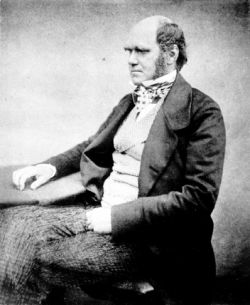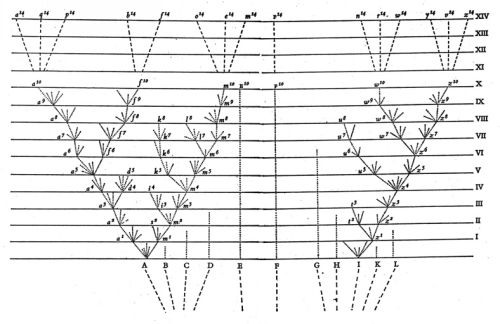Charles Darwin's
Theory of Evolution
I read a Christian magazine recently that complained about Charles Darwin's theory of evolution. More specifically, it complained that his book, Origin of Species, was more of a theological dissertation than a scientific treatise.
This page explains the problem that led Charles Darwin to his "dangerous idea." Click here for an explanation of the details of the theory of evolution itself.
 Charles Darwin around the time he wrote Origin of Species
Charles Darwin around the time he wrote Origin of SpeciesIt's not true. The person who wrote that complaint did not understand what led Darwin to the idea of "natural selection." The writer did not understand what problem the Darwin's theory of evolution was meant to solve.
Darwin's job, as a naturalist, was to classify each species by whether or not it was created individually by God.
I can entertain no doubt, after the most deliberate study and dispassionate judgment of which I am capable, that the view which most naturalists entertain, and which I formerly entertained—namely, that each species has been independently created—is erroneous. (Origin of Species, ch. 5)
It took only a little time for him to find out that such decisions were impossible to make with any degree of certainty.
A considerable part of the difficulty in recognising a variable species in our systematic works, is due to its varieties mocking [i.e., imitating], as it were, some of the other species of the same genus. A considerable catalogue, also, could be given of forms intermediate between two other forms, which themselves must be doubtfully ranked as either varieties or species; and this shows, unless all these forms be considered as independently created species, that the one in varying has assumed some of the characters of the other, so as to produce the intermediate form. (ibid., ch. 5, emphasis mine)
Mr. H. C. Watson, to whom I lie under deep obligation for assistance of all kinds, has marked for me 182 British plants, which are generally considered as varieties, but which have all been ranked by botanists as species ... Under genera, including the most polymorphic forms, Mr. Babington gives 251 species, whereas Mr. Bentham gives only 112,—a difference of 139 doubtful forms! (ibid., ch. 2)
The Origin of Species
Charles Darwin's theory of evolution, which he called "natural selection" or "descent with modification," was an attempt to explain how species came about. Thus it was titled On the Origin of Species by Natural Selection. There was a reason for that name. The reason has everything to do with why Origin of Species contains theological statements.
Charles Darwin was a naturalist. That means that he studied nature. Today, he might be called a taxonomist. He studied and classified living organisms.
In Darwin's day almost everyone believed that each species was separately created. Darwin writes:
No one definition has satisfied all naturalists; yet every naturalist knows vaguely what he means when he speaks of a species. Generally the term includes the unknown element of a distinct act of creation. (On the Origin of Species, ch. 2)
Linnaean Classification:
Genera and Species
The designation Homo sapiens for humans gives the "genus" and "species" to which we belong scientifically.
There are other classification levels. Humans, for example, are:
- Kingdom: Animal
- Phylum: Chordata
- Class: Mammalia
- Order: Primates
- Family: Hominidae
- Genus: Homo
- Species: sapiens
The plural of "genus" is "genera."
The problem with this is that some creatures that clearly seemed to be separate creations were known not to be.
One specific example mentioned by Darwin was domesticated pigeons. These varied so greatly in size and form that they seemed to be not only multiple species, but also multiple genera [genera is plural of genus, see sidebar].
However, everyone knew all domesticated pigeons descended from Rock Pigeons. Thus, no matter how different they were and whether or not they could interbreed, they all had to be one species.
Charles Darwin Theory of Evolution:
Classifying Species
Darwin, in his role as a naturalist, had to determine which types of plants and animals were separately created and which were descended from a common ancestor (like the various breeds of dogs).
Only those who have done that can know how difficult it is. Creationists like to say that life falls neatly into categories, but it does not. Which cats have a common descendant, and which were separately created? Which rodents? Which oak trees?
What about geese and ducks? Could they be related?
Are they more different than St. Bernards and dachshunds?
Darwin's theory of evolution is the product of addressing exactly such question.
When a young naturalist commences the study of a group of organisms quite unknown to him … his general tendency will be to make many species, for he will become impressed … with the amount of difference in the forms …
As he extends the range of his observations, he will meet with more cases of difficulty; for he will encounter a greater number of closely-allied forms. But if his observations be widely extended, he will in the end generally be able to make up his own mind: but he will succeed in this at the expense of admitting much variation.
Certainly no clear line of demarcation has as yet been drawn between species and sub-species. (ibid.)
In other words, when a naturalist is young and relatively ignorant, he knows few forms and considers most of them to be separate species. However, as he becomes more experienced and encounters more forms, the gaps begin to fill in, and it becomes difficult to determine what is a species and what a mere variation.
In other words, intermediate forms—or missing links, as we are prone to calling them—are not only found in the fossil record, but in living species as well!
Intermediate Forms
and the Progression of Life
Darwin began to see a progression in living creatures. This is exactly, according to Darwin himself, what led to the his theory of evolution (or "descent with modification," as he called it) ...
These differences blend into each other by an insensible series; and a series impresses the mind with the idea of actual passage. (ibid.)
 Darwin's illustration of the tree of life from Origin of Species
Darwin's illustration of the tree of life from Origin of SpeciesPublic domain
I would love to use Darwin's own words to explain what he was seeing, but since they are 150 years old it is better to paraphrase in my own words. This, updated somewhat in grammar and wording, is the explanation Darwin himself gave in Origin of Species for how he saw this progression:
In my opinion individual differences are of great importance for us. They are the first step towards barely noticeable varieties, hardly worth recording in science books.
Then, varieties that are in any degree more distinct or more permanent are steps leading to more strongly marked and more permanent varieties. These more distinct and permanent varieties then lead to subspecies, which lead to species.
The cause of a variety going from slightly different from its parent to being more different is natural selection. Natural selection accumulates these differences of structure in definite directions.
Hence, I believe a well-established variety may rightly be called an incipient [i.e., budding or beginning] species. (ibid.)
In other words, it was clear from the tight progression in living organisms that each variety was slowly developing into a new species.
Not all of them make it, of course. Some varieties die out, never making it to become classed as their own species, or they interbreed again with the parent stock. Many, though, continue to develop, becoming further and further from their parents, leaving a long line of barely recognizable distinctions in their wake.
This was the origin and content of Charles Darwin's Theory of Evolution.
Charles Darwin Theory of Evolution
Life As We Know It Today
As varieties and species go extinct, gaps are made in the living organisms found on earth. Thus in some cases we can find the whole progression of varieties still alive and thriving, making it difficult to classify some forms of life. In other cases, however, where a variety or whole series of varieties have gone extinct, gaps are created, allowing us to easily distinguish specific species.
This was the speculation of the Charles Darwin theory of evolution.
Darwin was aware when he wrote those words in chapter 2 of Origin of Species that they were mere speculation; speculation based on much research and thought as a naturalist, but speculation nonetheless.
The Scientific Method
Jesus said, "A tree is known by its fruit." He said it in the context of testing those who claim to speak the Word of God to us. We would know whom we can trust and whom we cannot trust by the results they produce.
Those of us who are Christians need to take note of the scientific method because it honors "fruit."
Nothing in science should cause us to trust their ideas on society, love, religion, politics or any other such subject. Science has no fruit to show us in such areas. One look at America and its suspected 30% depression rate should be enough to convince us that science has produced no knowledge about what constitutes quality of life.
But on the matter of natural laws?
There the "fruit" of science cannot be disputed.
"Either make the tree good, and the fruit good, or make the tree corrupt, and its fruit corrupt." – Jesus Christ
Whether this belief be justifiable must be judged by the general weight and several facts and views given throughout this work. (ibid.)
Darwin, like all scientists, did not leave the Charles Darwin Theory of Evolution as mere speculation. He researched; he asked questions; he experimented; he consulted other scientists. In other words he tested his speculations, which are known in science not as speculations but as hypotheses.
The scientific method encourages speculation, but it never leaves a hypothesis as speculation. It subjects hypotheses to the most rigorous examination and testing possible. In this way, truth—good, practical, useful truth that heals diseases and sends spaceships to Jupiter's moons—is determined.
It is the rest of this site that looks at the rigorous examination and testing to which Darwin's speculation, his theory of evolution, has been put. That cannot be done on one page. But I invite you to explore ...
- The evidence for evolution
- Evidence presented by those opposing evolution
- ... or take part in scrutinizing it yourself!